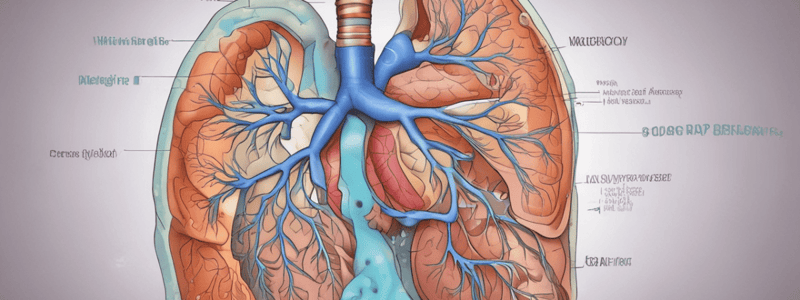Podcast
Questions and Answers
What is the chromosomal location of the asthma gene responsible for atopy?
What is the chromosomal location of the asthma gene responsible for atopy?
- Short arm of chromosome 1
- Short arm of chromosome 11 (correct)
- Short arm of chromosome 7
- Long arm of chromosome 5
What is the primary characteristic of orthopnoea?
What is the primary characteristic of orthopnoea?
- Chronic airway obstruction
- Upper airway noise when inhaling
- Difficulty breathing when lying flat (correct)
- Coughing up blood
What is a common fungal infection that can be caused by an asthma inhaler?
What is a common fungal infection that can be caused by an asthma inhaler?
- Oral candidiasis (correct)
- Pneumocystis pneumonia
- Aspergillosis
- Histoplasmosis
What is the pathogen responsible for causing influenza?
What is the pathogen responsible for causing influenza?
What is the term for the symptoms of asthma that worsen in the early morning?
What is the term for the symptoms of asthma that worsen in the early morning?
What is the definition of stridor?
What is the definition of stridor?
What is the primary purpose of a spacer in an asthma inhaler?
What is the primary purpose of a spacer in an asthma inhaler?
What is the primary cause of sinusitis?
What is the primary cause of sinusitis?
What is the term for the decreased movement and hyperinflation of the chest seen in asthma patients?
What is the term for the decreased movement and hyperinflation of the chest seen in asthma patients?
What is the preferred treatment for an asthma attack in a dental setting?
What is the preferred treatment for an asthma attack in a dental setting?
What is the third feature of asthma?
What is the third feature of asthma?
What is the name of the condition characterized by coughing up blood?
What is the name of the condition characterized by coughing up blood?
What is the term for shortness of breath?
What is the term for shortness of breath?
What is the main characteristic of paroxysmal nocturnal dyspnoea?
What is the main characteristic of paroxysmal nocturnal dyspnoea?
What is the name of the infection that can cause laryngeal oedema and a hoarse voice?
What is the name of the infection that can cause laryngeal oedema and a hoarse voice?
What is the primary cause of rhinitis?
What is the primary cause of rhinitis?
What is the definition of asthma?
What is the definition of asthma?
What are the two main components of the Orthomyxovirus that causes influenza?
What are the two main components of the Orthomyxovirus that causes influenza?
Which of the following extrinsic factors is most likely to trigger an asthma attack in a patient with atopic allergy?
Which of the following extrinsic factors is most likely to trigger an asthma attack in a patient with atopic allergy?
What is the primary mechanism underlying bronchial hyper-reactivity in asthma patients?
What is the primary mechanism underlying bronchial hyper-reactivity in asthma patients?
Which of the following signs is most indicative of an asthma exacerbation?
Which of the following signs is most indicative of an asthma exacerbation?
What is the primary purpose of lung function tests, such as PEFR tests, in diagnosing asthma?
What is the primary purpose of lung function tests, such as PEFR tests, in diagnosing asthma?
Which of the following medications is contraindicated in asthma patients?
Which of the following medications is contraindicated in asthma patients?
What is the primary reason why asthma patients are advised to rinse their mouth after using an inhaler?
What is the primary reason why asthma patients are advised to rinse their mouth after using an inhaler?
What is the characteristic of wheeze?
What is the characteristic of wheeze?
What is the cause of rhinitis?
What is the cause of rhinitis?
What is the primary feature of pharyngitis?
What is the primary feature of pharyngitis?
What is the characteristic of paroxysmal nocturnal dyspnoea?
What is the characteristic of paroxysmal nocturnal dyspnoea?
What is the feature of laryngo-tracheo-bronchitis?
What is the feature of laryngo-tracheo-bronchitis?
What is the characteristic of orthopnoea?
What is the characteristic of orthopnoea?
What is the primary reason for increased mucus production in asthma patients?
What is the primary reason for increased mucus production in asthma patients?
Which of the following is an intrinsic factor of asthma?
Which of the following is an intrinsic factor of asthma?
What is the primary effect of bronchial hyper-reactivity on the airways?
What is the primary effect of bronchial hyper-reactivity on the airways?
What is the purpose of a lung function test, such as a PEFR test, in diagnosing asthma?
What is the purpose of a lung function test, such as a PEFR test, in diagnosing asthma?
Why are patients with asthma advised to rinse their mouth after using an inhaler?
Why are patients with asthma advised to rinse their mouth after using an inhaler?
What is the primary effect of asthma on the airway?
What is the primary effect of asthma on the airway?
What is the primary function of the peak expiratory flow rate (PEFR) test?
What is the primary function of the peak expiratory flow rate (PEFR) test?
What is the result of the damage to the air sacs in the lungs of people with emphysema?
What is the result of the damage to the air sacs in the lungs of people with emphysema?
What is the characteristic of bronchiectasis?
What is the characteristic of bronchiectasis?
What is the consequence of the widened airways in bronchiectasis?
What is the consequence of the widened airways in bronchiectasis?
What is the common feature of emphysema and bronchiectasis?
What is the common feature of emphysema and bronchiectasis?




